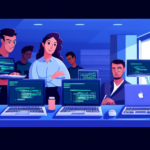“`html
Unmasking the Hackers: Insights into Today’s Most Dangerous Cyber Threats
Introduction
In today’s interconnected digital world, cybersecurity has become an increasingly crucial aspect of personal and organizational safety. As technology advances, so too do the methods employed by cybercriminals, making the landscape of cyber threats more sophisticated and frequent. This article delves into the most dangerous cyber threats, providing insights into their nature, impact, and mitigation strategies.
Types of Cyber Threats
Malware
Malware, short for malicious software, encompasses a broad range of harmful programs designed to disrupt, damage, or gain unauthorized access to computer systems. Common forms include viruses, worms, and ransomware. Viruses replicate themselves and spread to other files, while worms propagate across networks without requiring user intervention. Ransomware encrypts files, demanding payment for their release. These threats can cause significant disruption to both individuals and organizations.
Phishing Attacks
Phishing attacks involve tricking users into revealing sensitive information, such as passwords or credit card details, through deceptive emails or websites. Common tactics include mimicking legitimate entities and creating urgency to prompt quick action. Phishing remains one of the most prevalent and effective methods for cybercriminals, often serving as the entry point for more serious attacks.
Distributed Denial of Service (DDoS) Attacks
DDoS attacks overwhelm a targeted system with excessive traffic, rendering it inaccessible to legitimate users. These attacks can cripple businesses, leading to financial losses and reputational damage. Notable incidents include the 2016 attack on Dyn, which disrupted major services like Twitter and Netflix.
Insider Threats
Insider threats arise from current or former employees, contractors, or business associates who misuse their authorized access. These can be either accidental, due to negligence, or intentional, driven by malice. Insider breaches can lead to severe data leaks and operational disruptions.
Advanced Persistent Threats (APTs)
APTs are sophisticated, long-term attacks conducted by highly skilled and well-resourced adversaries. They typically target critical infrastructure and sensitive data, aiming to remain undetected for extended periods. APTs pose significant risks to national security and economic stability.
Common Tactics and Techniques
Hackers employ various methods to exploit vulnerabilities, including social engineering, zero-day exploits, and credential stuffing. Social engineering manipulates human psychology to gain unauthorized access. Zero-day exploits leverage previously unknown vulnerabilities, while credential stuffing involves automated testing of stolen credentials across multiple sites. Additionally, botnets and command-and-control servers facilitate large-scale attacks by coordinating numerous compromised devices.
Impact of Cyber Threats
The financial, reputational, and operational impacts of successful cyberattacks can be profound. Businesses may face substantial financial losses, damaged reputations, and operational disruptions. Governments also suffer from national security risks and privacy concerns. The broader societal implications include compromised personal data and reduced trust in digital platforms.
Current Trends and Emerging Threats
Recent trends in cybercrime include the rise of state-sponsored hacking and the increased targeting of Internet of Things (IoT) devices. Emerging threats like quantum computing and artificial intelligence present new challenges for cybersecurity, necessitating continuous adaptation and innovation.
Mitigation Strategies
To protect against these threats, individuals and organizations should adopt strong password management, regular software updates, and employee training. Best practices include multi-factor authentication, encryption, and incident response planning. Vigilance and proactive measures are essential in building robust defenses against evolving cyber threats.
Conclusion
In conclusion, the digital world faces an array of complex and ever-evolving cyber threats. Understanding these threats and implementing effective mitigation strategies is crucial for safeguarding personal and organizational assets. Ongoing vigilance and collaboration between stakeholders are vital to combating these challenges and ensuring a secure digital environment.
“`


